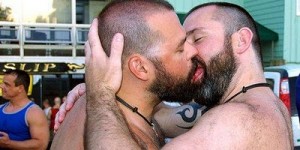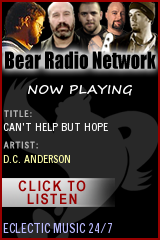NOIRPINK MODELLO PANDEMONIUM

This interview from the Italian magazine Noir Pink, published December 2010, can be found in Italian here.
+
1) Les K. Wright reported the “fascism of body” and the “masculinity police”, while for Javier Sàez there’s no problem “because people are free to join the bear culture or to quit it if they want”… And for you? Which is the relationship between freedom and bear culture? How could we conciliate real freedom and high homogenization in style, dressing, attitude and so on?
Our increasingly interconnected society has allowed many more types of previously closeted gay and bi men to recognize their homosexuality, despite the fact that their body type or image does not resemble what we have come to think of feminine or gay. Nor do they find themselves attracted to what we typically think of as gay or queer culture.
Men who identify as bears and with the bear movement have no more nor less freedom than anybody else: not from stereotypical behavior or attitudes, nor from the positive and negative influences of their cultures, nor from the polarizing and dichotomous labeling of femininity and masculinity.
In a post-Brokeback Mountain culture, I think many bear-identified men do feel themselves freer than they might have in the past because of the visibly increasing numbers of older GLBTIQs who are coming out later in life. So it may appear that among Bears there is a great deal of homogenized fashion, but just as there is now a greater age range of queers, there is actually an increasingly diverse array of body types. So we see Bear-identified clothing designers creating fashion trends the celebrate “the Bear look,” along with all the other marketing aimed at queers.
This idea of joining or quitting the Bear community is problematic. Even though I am more wolf-identified personally, I consider myself deeply in the Bear community, though I can’t say when it was I “joined” it. I’ve always been attracted to Bears and thus involved in Bear communities. I’m implicated in Bear culture too far professionally at this point to consider leaving: as Jack Twist said in Brokeback, “I wish I knew how to quit you.”
+
2) Why do we see so few black bears? How does bears relate to black people? And how black gays relate to bears?
You might be better off asking this of a bear of color, but as a man of mixed (Native American/Jewish/Latin) ethnic descent, I can venture a few guesses. First, the bear media is basically white owned and operated, and the images we see in their editorial and advertising content reflect that ethnic / racial orientation.
In 2000, I did an online discussion on this topic “Ethnic Bears and Bears of Color” for my book Bears on Bears, which considered reasons why we see so few black bears. I was just at the Halloween weekend Bear run, Spookybear, in Provincetown, and my observation of the attendees was that there were more bears of color — not just black bears but Latinos, Asians, and other non-white Bears — perhaps twice as many, as there were ten years ago. It is likely that Bears in certain communities outside the USA have made greater inroads toward racial and ethnic integration but I am not certain. In any case, I think that increased visibility of Bears of color reflects a trend in the gaystream toward greater racial and ethnic integration, and not particular to the Bear community.
+
3) There is a specific bear aesthetics, but… is there a specific sexuality? E.g., are there sexual practises that are more diffused in bear community and pornography?
This question is unclear to me. Do you mean there are sexual practices that are more common in Bear culture than in gaystream culture? Does it relate to Bears as pornographic images, to promiscuity in the Bear community, or to sexual and gender expression as Bears? Again, some of this is unpacked in Bears on Bears in several discussions on Bearsex and Bear sexual health.
That are marketing surveys of Bear-identified guys, but to my knowledge, there are no empirical studies on sexual behavior solely in the Bear community, but I would love to see that happen. Aside from that, my own personal observation is that Bears are the most fabulous huggers and cuddlers.
+
4) Is there a bisexual bear community? The gay world is characterized by “castes” (bears, twinks, sissies, stallions, daddies, leather-men, and so on): is it the same for bisexual men?
Urban Dictionary defines “bi-polar bear” primarily as two things: 1. a person who has bi-polar disorder but who is also really, really adorable; and 2. a Bisexual polar bear. Which definition do you favor?
I believe that, as a mature homomasculine population and gay male subculture, a strong affinity between Bears and Bi men exists. At the 9th International Conference on Bisexuality in 2006, my coeditor for the anthology Bi Men: Coming Out, Pete Chvany, and I conducted a group discussion on the topic of Bi Bears, the first time the topic had been considered in a public forum. I think there is considerable overlap between the two queer communities, but other than a few online groups (a Bi Bears yahoo!group had several hundred members at one point), there is not much activity or social networking.
Although I know many Bears who consider themselves bisexual to some extent, I don’t believe that there is much actual identity formation or social functioning around this distinction. If something more visible was likely to emerge, it would likely be from the more organized Bear community, as currently there is not much social (nonsexual) or political organization among bisexual men.
In my view, Bi Bears (otters, cubs, wolves, etc.) are the most masculine, virile, and versatile lovers. I’d love to conduct empirical research on this, so if you’re well-endowed (with a big fellowship) and would like to offer a field research grant, please do check out my website, ronsuresha.com, or contact me at bearsoup AT gmail DOTcom.


